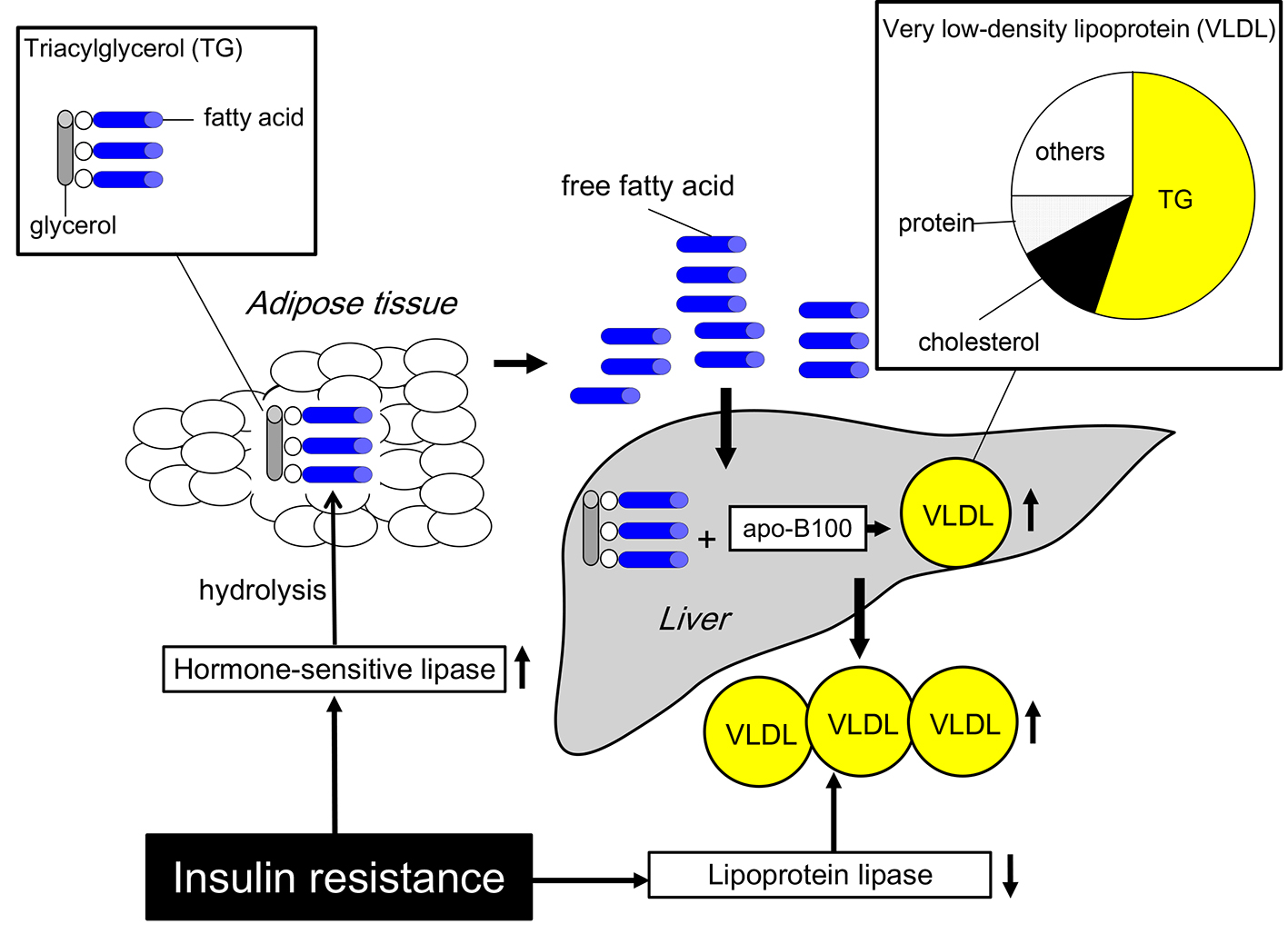| Journal of Endocrinology and Metabolism, ISSN 1923-2861 print, 1923-287X online, Open Access |
| Article copyright, the authors; Journal compilation copyright, J Endocrinol Metab and Elmer Press Inc |
| Journal website http://www.jofem.org |
Editorial
Volume 7, Number 4, August 2017, pages 101-102
VLDL Is the Leading Actor in Lipid Abnormality in Patients With Diabetes and Obesity
Hidekatsu Yanai
Department of Internal Medicine, National Center for Global Health and Medicine Kohnodai Hospital, 1-7-1 Kohnodai, Ichikawa, Chiba 272-8516, Japan
Manuscript submitted July 4, 2017, accepted August 15, 2017
Short title: Editorial
doi: https://doi.org/10.14740/jem432w
Very low-density lipoprotein (VLDL) is a triglyceride (TG)-rich lipoprotein which is produced by liver. We previously reported that VLDL clearly showed higher values in the order of type 2 diabetic patients with obesity (27.3 ± 22.7 mg/dL), type 2 diabetic patients without obesity (20.1 ± 16.2 mg/dL), subjects with low Framingham risk score (16.6 ± 12.8 mg/dL), and young lean men (4.0 ± 4.6 mg/dL) by using the anion-exchange high performance liquid chromatography data [1]. Further, we reported that the 2-week treatment using a glucagon-like peptide 1 (GLP-1) analog reduced VLDL from 27.3 ± 22.7 to 17.4 ± 7.8 mg/dL in obese patients with type 2 diabetes (BMI, 29.5 ± 7.0 kg/m2; HbA1c, 9.1±2.1%) [2]. In this study, changes in TG were significantly correlated with changes in VLDL (r = 0.99, P < 0.001). These previous studies strongly suggest that VLDL is the leading actor in lipid abnormality in patients with diabetes and/or obesity.
Insulin resistance which is induced by obesity is the main cause of the metabolic syndrome and type 2 diabetes, and increases activity and expression of hormone-sensitive lipase in adipose tissue, which hydrolyses TG, releasing free fatty acids (FFA) (Fig. 1) [3]. In an insulin resistant state, increased FFA entry to liver, reduced degradation of apoB100 and enhanced expression of microsomal TG transfer protein which is a key enzyme involved in VLDL assembly may elevate hepatic production of VLDL [4, 5]. Insulin resistance also decreases the activity of lipoprotein lipase, the rate-limiting enzyme of the catabolism of TG-rich lipoproteins such as VLDL [6].
 Click for large image | Figure 1. The abnormal lipid metabolism which may be observed in insulin resistance such as metabolic syndrome and type 2 diabetes. |
Hypertriglyceridemia and hypercholesterolemia which are commonly observed in patients with obesity and/or type 2 diabetes may be mainly induced by an increase of VLDL.
Conflicts of Interest
The author declares that he has no conflicts of interest concerning this article.
| References | ▴Top |
- Yanai H, Hirowatari Y, Ito K, Kurosawa H, Tada N, Yoshida H. Understanding of Diabetic Dyslipidemia by Using the Anion-Exchange High Performance Liquid Chromatography Data. J Clin Med Res. 2016;8(5):424-426.
doi pubmed - Yanai H, Hamasaki H, Adachi H, Moriyama S, Hirowatari Y. Effects of liraglutide, a human glucagon-like peptide-1 analog, on glucose/lipid metabolism, and adipocytokines in patients with type 2 diabetes. J Endocrinol Metab. 2011;1(3):149-151.
doi - Sztalryd C, Kraemer FB. Regulation of hormone-sensitive lipase in streptozotocin-induced diabetic rats. Metabolism. 1995;44(11):1391-1396.
doi - Fisher EA. The degradation of apolipoprotein B100: multiple opportunities to regulate VLDL triglyceride production by different proteolytic pathways. Biochim Biophys Acta. 2012;1821(5):778-781.
doi pubmed - Taghibiglou C, Carpentier A, Van Iderstine SC, Chen B, Rudy D, Aiton A, Lewis GF, et al. Mechanisms of hepatic very low density lipoprotein overproduction in insulin resistance. Evidence for enhanced lipoprotein assembly, reduced intracellular ApoB degradation, and increased microsomal triglyceride transfer protein in a fructose-fed hamster model. J Biol Chem. 2000;275(12):8416-8425.
doi pubmed - Nikkila EA, Huttunen JK, Ehnholm C. Postheparin plasma lipoprotein lipase and hepatic lipase in diabetes mellitus. Relationship to plasma triglyceride metabolism. Diabetes. 1977;26(1):11-21.
doi pubmed
This article is distributed under the terms of the Creative Commons Attribution Non-Commercial 4.0 International License, which permits unrestricted non-commercial use, distribution, and reproduction in any medium, provided the original work is properly cited.
Journal of Endocrinology and Metabolism is published by Elmer Press Inc.
